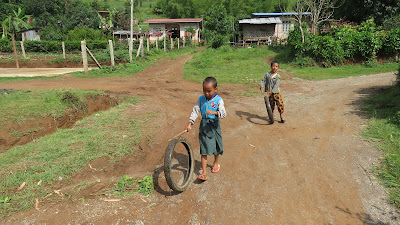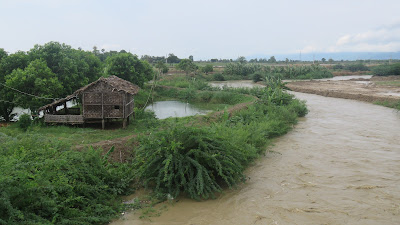Our transport and our local guide, Michel, on the right.
Scenes from the hike.
Planting and tending mandarin trees.
Traditional women from the local tribe.
Our excellent local lunch...
and where it was prepared.
Local farmer.
Picking tea leaves.
A beautiful lush area to walk.
Thursday, May 31st.
This hotel did not have a buffet or a la carte breakfast,
but instead set the table with a set breakfast. Orange juice, large papaya,
melon, mango and watermelon slices, a crepe pancake, whole wheat toast and two
eggs of your choice, excellent (and I get to have it again tomorrow!).
We were picked up by a driver and local guide and a
little truck for our trekking trip. They drove us about twenty minutes out of
town to a little village where we started our hike. We walked through the hills
past little farms growing all manner of fruits and vegetables. The weather was
mostly cloudy which was good as it made it cooler. We saw many people working preparing
the fields for the upcoming monsoon and the start of the growing season for rice
and other crops. We saw a small tea plantation and many fruit trees.
Most of the morning was up hill, as we crossed through
the fields and then onto a road that ran up into the hills. I was upfront for a
bit and stopped to talk to a family that were tending young orange or mandarin
trees. There were four adults and a young girl holding a baby. The girl spoke a
bit if English, so we were able to converse a bit. We stopped a little further at
a small village where we had lunch. As soon as we went into the family home, it
started to rain. We were talking amongst ourselves when two young Danish girls
came in with their guide and they were soaked through. They were traveling independently
and were interested in our trip, so we talked to them about it and GAdventures
and Intrepid. Our guide, Michel, had disappeared but came back a while later
with our food. Turns out he was in the kitchen preparing our food with the
family. They served us a chicken stock soup, rice, a chicken and potato dish
and three other cooked vegetable dishes. For dessert there was banana and
mango. It was a delicious meal. It rained for the whole time we were in that
house having lunch, but when Pu Pu asked if we wanted to walk back down (about
two hours) or take the truck, the weather seemed to brighten, and we opted to
walk, and we are glad we did because it stayed dry the whole way. The road
however, was a muddy and the red soil clung to our boots. However, we enjoyed
the hike as we went down a different road and partly through a pine forest. We
met our truck when we got back to the bottom and he drove us for a half hour
back to our hotel. We had hiked about 15 kilometres total through some
beautiful rural surroundings, great day. The rest of the afternoon was ours to
do what we wanted. I relaxed and showered and then asked the guy in the lobby
where I might find a barber. He gave me directions and I went and got my face
and head shaved for two dollars. As soon as I walked out of the barber shop it
started to rain and I went back to the hotel and it came down. Timing is everything
today.
We met up for dinner and went to a local Nepali restaurant
called Everest for dinner and then back for bed.



























































